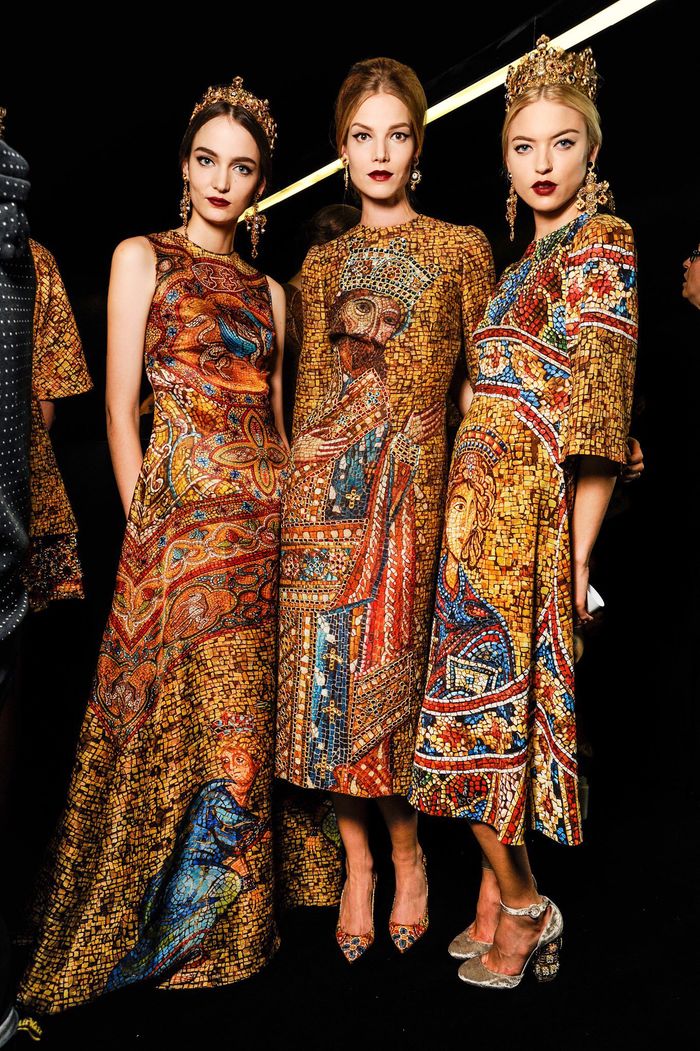Column reflections: is fashion blasphemous?
In the final instalment of her column on religion in fashion, Eliane Bedu concludes by reflecting on the implications of Christian representations in fashion
Throughout this column, I have analysed diverse religious manifestations in fashion in line with designers’ faith and inspirations. Now that we come to the end of the series, it is time to realise that I have not properly debated the appropriateness of these representations. Can the use of Christian symbols and clothing be legitimised on the grounds of the couturiers’ personal faith? Or is it blasphemous? The fashion industry has justified it as a tribute to Christianity, a “re-glorification” and “romanticization” of the Church. But is this really the case?
“The political symbol is taking over the spiritual, unintentionally becoming provocative. However, can these reinterpretations of the religious imagery be considered blasphemous if approved by the Church?”
The association between fashion and religion is not always met by unanimous approval in the Christian community. The 2018 Met Gala, which remains the benchmark event when it comes to religious representation in high fashion, received considerable attention, which was not entirely positive. Whereas religious inspirations had previously been subtle, hidden in the fold of a drape, the 2018 Met Gala vulgarised and popularised religious symbols in fashion to the point that Christianity has become a trend, something you buy only to throw away the next season. This commercialisation of beliefs has been seen by some as a desecration of the Church. But brands are not the only ones to blame. The Church takes part in its own fall, consorting with the “enemy”. Indeed, as I pointed out in the second article of this series, the Vatican lent many art pieces for the Met’s exhibition, and Cardinal Ravasi, chargé of cultural affairs, attended the event, though not all clerics supported the Church’s initiative. Father Jean-Bernard, interviewed by the newspaper Il Giorno, affirmed that the utilisation of the religious in fashion showed a society-wide lack of respect for the sacred and the proof of the believers’ corrupted faith; the normalisation of religious fashion as a market being a sign of the Church’s decline, despite its efforts to modernise itself.
The problem with religious representation in fashion is its political dimension. The over-sexualisation of Christian figures is accentuated on runways. Taylor Hill’s barely-covered cardinal and Rihanna’s mini pope dress proved it in 2018, leading to the launch of the hashtag #MyReligionIsNotYourCostume on Twitter. These are not the only examples. In 2019, Giuseppe Veneziano, a Sicilian Painter, represented Jesus on the Cross, wearing Dolce & Gabbana leopard briefs. As one can assume, it didn’t really please conservative Christians. The political symbol is taking over the spiritual, unintentionally becoming provocative. However, can these reinterpretations of the religious imagery be considered blasphemous if approved by the Church? Can it be called out as cultural appropriation when most of the designers are believers themselves?
Sadly for us, no line is drawn between freedom of expression and blatant disrespect, making the task no easier. It seems evident that religious symbolism cannot be mocked and treated as a vulgar accessory which we hasten to sell on Depop as soon as the season is over. But caricatures do not always mean harm, nor does creative innovation. Monet’s Impression, Sunrise caused quite the scandal when it was exhibited for the first time in 1874. Giving its name to impressionism, it was too anti-academic to be considered a serious piece of art. Today, the painting prefigures as a reference when it comes to art of the industrial revolution period. Similarly, Baudelaire’s Fleurs du Mal led him to being put on trial for contempt of public morals as the exotic inspirations and explicit sexual references shocked the high-bourgeoisie. Les Fleurs du Mal is now taught in schools, being probably the most famous collection of poems in France.
The same phenomenon is happening with fashion. Falsely accused of superficiality, it challenges society’s codes by introducing the sacred in its designs. The magnificence of Christian art, the world-wide worship it inspires and its divine stature represents endless inspirations for designers. Their modern reinterpretations can come as a surprise, approaching religion from an angle we’ve never seen before. But that does not mean it is a bad thing. With Church’s attendance declining, the growth of religious representation blows a modern wind, presenting Christianity as more open and compatible with a 21st century life. I don’t believe that art can be blasphemous. It can be provocative, for sure, but it would never ridicule its own source of inspiration. Whether designers are religious or not, the fact that they use religious symbols in their creations prove the respect and admiration they have for Christianity, both as a spirituality and an artistic influence throughout history.
 News / Clare Hall spent over £500k opposing busway 24 December 2025
News / Clare Hall spent over £500k opposing busway 24 December 2025 Comment / The ‘class’ of Cambridge24 December 2025
Comment / The ‘class’ of Cambridge24 December 2025 News / Caius mourns its tree-mendous loss23 December 2025
News / Caius mourns its tree-mendous loss23 December 2025 Comment / League tables do more harm than good26 December 2025
Comment / League tables do more harm than good26 December 2025 News / Girton JCR publishes open letter expressing solidarity with Palestine25 December 2025
News / Girton JCR publishes open letter expressing solidarity with Palestine25 December 2025









